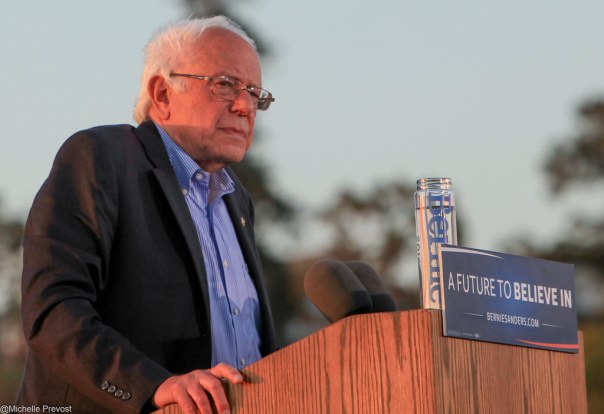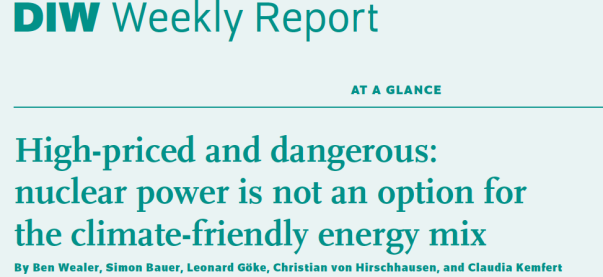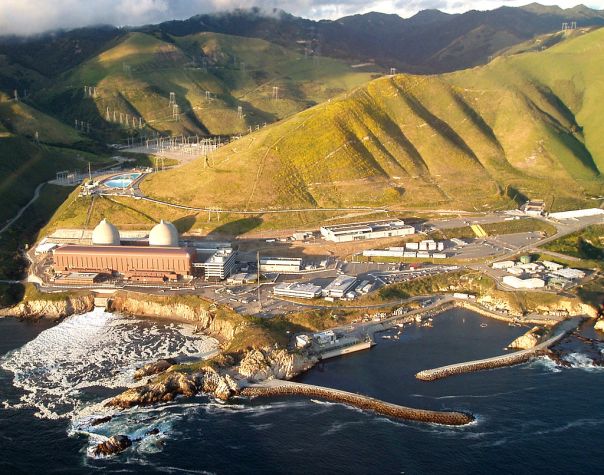“Nuclear energy has never been a clean economical energy source and will not be in the future”
By Linda Pentz Gunter
On August 25, 2019, the Washington Post published an editorial condemning Independent Vermont senator, Bernie Sanders, also a Democratic presidential candidate, for, among other things, excluding nuclear power from his version of the Green New Deal. The Post declared that:
“Mr. Sanders also promises to make his plan unnecessarily expensive by ruling out a long-established source of carbon-free electricity: nuclear power. Not only would he halt the building of new plants, but he also would deny re-licensing to the existing ones that now provide about 20 percent of the nation’s electricity.”

The Washington Post condemned Bernie Sanders’s anti-nuclear Green New Deal. We disagreed. (Photo: Michelle Prevost through photogism, licensed under CC BY 2.0)
As one anti-nuclear colleague said on reading that: “he gets my vote right there!”
Specifically, Sanders’s $16.3 trillion climate plan included this:
“Phase out the use of non-sustainable sources. This plan will stop the building of new nuclear power plants and find a real solution to our existing nuclear waste problem. It will also enact a moratorium on nuclear power plant license renewals in the United States to protect surrounding communities. We know that the toxic waste byproducts of nuclear plants are not worth the risks of the technology’s benefit, especially in light of lessons learned from the Fukushima meltdown and the Chernobyl disaster. To get to our goal of 100 percent sustainable energy, we will not rely on any false solutions like nuclear, geoengineering, carbon capture and sequestration, or trash incinerators.”
We took issue with the Washington Post’s claim that Sanders’s exclusion of nuclear power made his proposal “unnecessarily expensive,” especially given the fact that nuclear power is, itself, wildly expensive and relies for its continued existence on massive subsidies. So we wrote back, and our letter was published beneath the August 29th editorials, under the category “Taking exception.”
It was startling, but not uncommon, to see the claim made by the Post, that nuclear power is somehow an “affordable option.” The editorial board provided no source reference for its claim that axing nuclear upped the price of Sanders’s plan. But there are plenty of examples that demonstrate how including nuclear power would place a continued economic burden on consumers, and even governments, and that this has always been the case.
To support this, a revelatory 2019 German study from DIW just appeared, under the title: High-priced and dangerous: nuclear power is not an option for the climate-friendly energy mix. In it, the authors show that every single nuclear power plant ever built was financially unsuccessful.

A revelatory report from the German Institute for Economic Research (DIW Berlin)
As the study states, “the authors carried out a descriptive empirical analysis of all 674 nuclear reactors used to produce electricity that have been built since 1951.” After extensive running of numbers, they concluded:
“The results showed that in all cases, an investment would generate significant financial losses. The (weighted) average net present value was around minus 4.8 billion euros ($5.2 billion). Even in the best case, the net present value was approximately minus 1.5 billion euros. The authors included conservative assumptions with high electricity prices, low capital costs, and specific investment. Considering all assumptions regarding the uncertain parameters, nuclear energy is never profitable.”
The study findings “show that nuclear energy has never been a clean economical energy source and will not be in the future.” Since the 1960s, the researchers found, “the construction of new nuclear power plants has not led to a reduction in fixed unit costs. Instead, the cost per kilowatt (kW) of nuclear power plant output has steadily risen.”
The other observation it makes right in the abstract, one which nuclear power proponents can’t wait to disavow — since the last thing they want is to be associated with atomic bombs — is this one:
“An empirical survey of the 674 nuclear power plants that have ever been built showed that private economic motives never played a role. Instead military interests have always been the driving force behind their construction.”
In our letter, we point out that wildly uneconomic history and present of nuclear power.
“According to research by the Environmental Working Group, five states have already spent $15 billion in subsidies to keep their economically failing nuclear plants open. In Ohio, a whopping $1.1 billion was lavished on just two old nuclear plants whose owners had planned to shutter them. That bill will be paid by consumers.”
In Ohio, FirstEnergySolutions, owner of the plants, was in bankruptcy protection and was actually trying to close the reactors at Perry and Davis Besse when the state bailed the company out. But the deal passed by the Ohio legislature also effectively stifled progress on renewable energy in that state while actually stimulating coal — a lose-lose for climate all around. And, as that Inside Climate News article also pointed out, “The new law also freezes annual increases in energy efficiency standards at the end of 2020, meaning utilities will no longer need to operate programs that help customers reduce their energy use.” So any pretense that this was all in the name of climate change completely flies out of the window,
In our Washington Post letter, we also pointed out that:
“New nuclear construction has proved to be economically unpalatable to most companies and impossible without loan guarantees. In Georgia, $25 billion has already been poured into two new plants at Vogtle, still unfinished. In South Carolina, two reactors under construction were canceled, leaving customers with a $9 billion tab and not a single watt of electricity.
“That’s already $49 billion, without considering constant safety maintenance, the unsolved management of radioactive waste and, of course, the incalculable price of a major accident.”
The DIW study notes the characteristically ballooning costs at Vogtle, as in France and Finland at new reactor sites there, with “the original 14 billion U.S. dollars (equal to around 6,200 U.S. dollars per kW) in 2013” now at “an estimated 29 billion U.S. dollars in 2017 (equal to around 9,400 U.S. dollars per kW).”

Diablo Canyon sits at sea level on two fault lines. What could possibly go wrong? (Photo: r marya/Wikimedia Commons)
In California, the impending closure of the Diablo Canyon nuclear power plant in 2025 will finally render the state nuclear-free. That has put the anti-renewable front groups with the silly names — Californians for Green Nuclear Power (it isn’t), and Environmental Progress (they want the opposite) — in a tizzy. This desperation resulted in Republican California Assemblyman, Jordan Cunningham’s ridiculous constitutional amendment that seeks to reclassify nuclear power as a source of renewable energy and zero carbon.
In reality, it is a hollow rebranding attempt by an economically failing industry that can only stay afloat with giant subsidies.
As most people reading this already know, nuclear power relies on uranium for its fuel, an ore that must be mined and is finite in supply, not renewable. Nor is nuclear power zero-carbon. After mining comes milling, then fuel processing, fabrication and transportation, releasing greenhouse gases at every phase. These CO2 releases may be lower than those of fossil fuels, but it is false to claim “zero.”
Diablo Canyon’s output can easily be replaced by renewable energy and efficiency, which is exactly what the state of California plans to do. Closing the plant also avoids the growing likelihood of a catastrophic outcome should a major earthquake destroy Diablo Canyon, which sits on two major fault lines, not to mention at sea level.
Assemblyman Cunningham suggests nuclear power can become a valuable asset. But, just like its namesake plant in Connecticut, nuclear power is a millstone around the necks of its corporate owners.
By the way, if you put the Ohio bailout numbers into a Google search it will ask you “Did you mean: $1.1 million?” Yes, even Google can’t believe the cost.
Note: Beyond Nuclear is a 501(c)(3) and, as such, does not endorse political candidates. However the organization and its staff are free to support and promote the policies of candidates with which they agree.
 Beyond Nuclear International
Beyond Nuclear International
Pingback: Expensive Nuclear Power and the Green New Deal - The Colorado Coalition
Pingback: The decline and fall of nuclear power — Beyond Nuclear International « nuclear-news
Pingback: The decline and fall of nuclear power — Beyond Nuclear International « Antinuclear